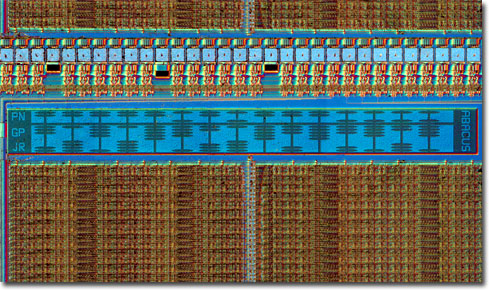Hewlett-Packard Abacus
|
A Hewlett-Packard design team headed by Howard Hilton in Lake Stevens, Washington was responsible for placing what is perhaps the World's smallest abacus (illustrated above) on a wide dynamic range analog-to-digital converter integrated circuit. In many respects, the contrast between an abacus and a complex integrated circuit highlights the dramatic improvement in technology that has occurred over the past millennium. Code named Abacus or 1FW6, the chip was used exclusively for Hewlett-Packard products and never sold outside the company. The logical design was engineered by Jerry Ringel (also in Lake Stevens), while Gary Petrie and Paul Nuber produced the physical design in Fort Collins, Colorado. The initials of these three designers appear on the left-hand portion of the abacus, which measures almost 5 millimeters long. It is interesting to note that, by adding an implicit decimal point after the first digit, the abacus version layered onto the chip displays the number 3.14159265358979, the value of pi accurate to 14 decimal places (as brought to our attention by Keith Thompson of the San Diego Supercomputer Center). The chip was loaned for imaging by Dr. John Guilford of Agilent Technologies (formerly Hewlett-Packard). Long before the invention of computers and electronic calculators, the abacus was developed as a mechanical aid for counting. Predating the evolution of numerals, merchants required a method to easily calculate the cost of goods bought and sold, as well as the volume traded. One can easily imagine that the simplest counting boards consisted of lines drawn in the sand, representing units such as powers of ten, and pebbles or shells deposited within those lines as place holders, representing numbers. More permanent (and mobile) boards were most likely constructed from wood, and then later of stone or metal, as world commerce flourished. The placeholders were probably upgraded from pebbles or shells to crafted wooden, stone, or metal beads, leading to the invention of the handheld abacus around 500 AD by the Romans. The oldest surviving counting board is the Salamis tablet used by the Babylonians around 300 BC, while the Egyptians originated the bead and wire abacus about 500 BC. At the end of the Middle Ages, the use of the abacus fell out of favor in Europe as arithmetic, or counting using written numbers, gained popularity. The abacus that is familiar to most of us was developed in China around 1,200 AD and was known as saun-pan. By way of Korea during the seventeenth century, the abacus evolved in Japanese culture as the soroban, with newer, more innovative designs. Independently, the Aztecs developed their own version of the abacus about 900 AD using the culturally important maize kernels arranged in a 7-bead by 13-thread matrix. The Chinese abacus typically features 13 vertical wires with 7 beads on each wire. Within the rectangular mounting frame is a horizontal divider, arranged with two beads above the divider (the heaven beads), and five beads beneath (the Earth beads). Redesigned by the Japanese mathematician Seki Kowa, the soroban features four beads below the divider and one bead above, on each of 21 wires or columns. A Russian variation, utilized to calculate in rubles and kopeks, lacks a horizontal divider, but replaces these place keepers with beads of different colors. The person operating the abacus performs mathematical calculations mentally, but uses the abacus to keep track of the sums, the "carry's", and intermediate results. With a modern abacus in the hands of a skilled operator, determining square roots and cubic roots of numbers is possible as is simpler multiplication, division, addition, and subtraction. In 1946, a celebrated contest in Tokyo pitted a Japanese abacus against an electric calculating machine, with the abacus winning a decisive victory. Although slide rules, mechanical and electronic calculators, and computers have largely replaced the abacus in everyday commerce and mathematics in Western cultures, there are still fans of the more aesthetically pleasing abacus, particularly among Japanese merchants. |
© 1995-2025 by Michael W. Davidson and The Florida State University. All Rights Reserved. No images, graphics, software, scripts, or applets may be reproduced or used in any manner without permission from the copyright holders. Use of this website means you agree to all of the Legal Terms and Conditions set forth by the owners.
This website is maintained by our
|
